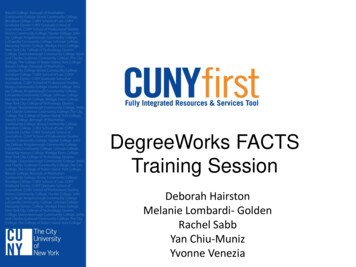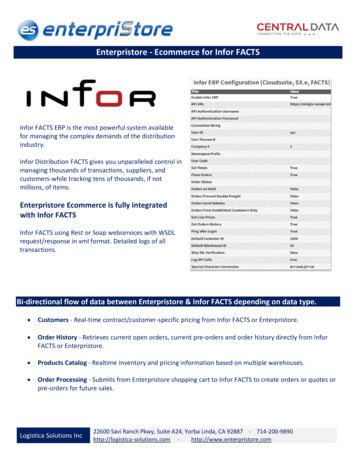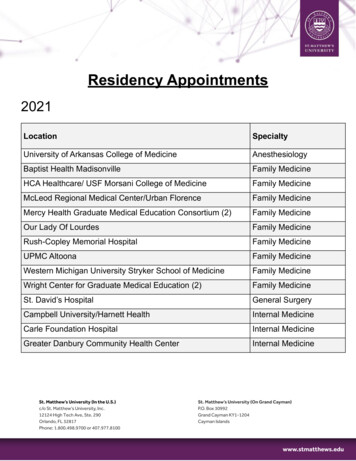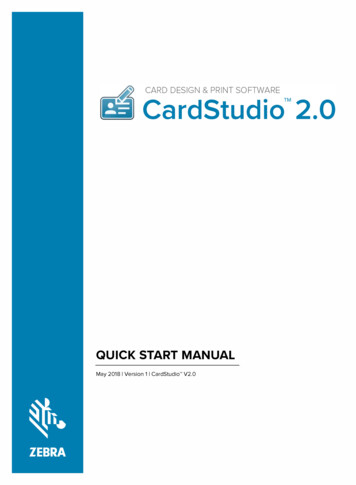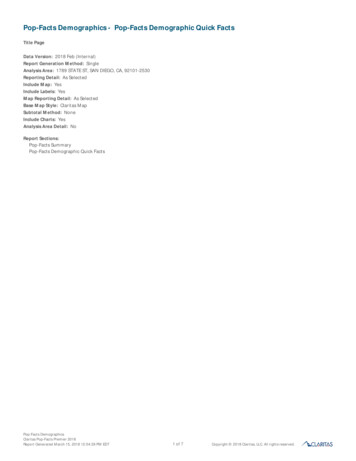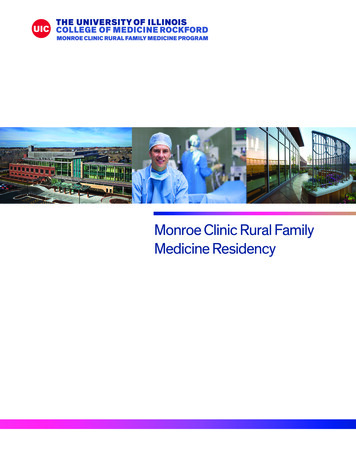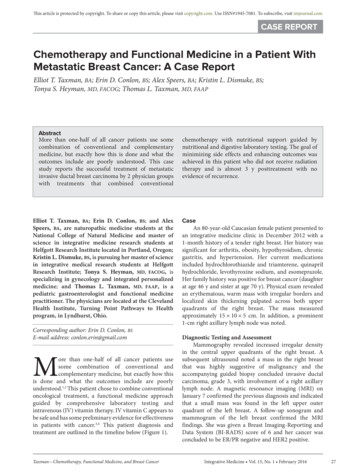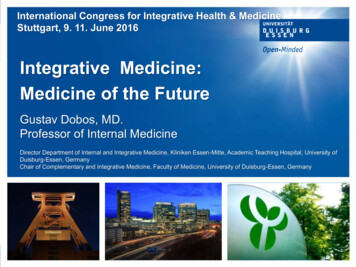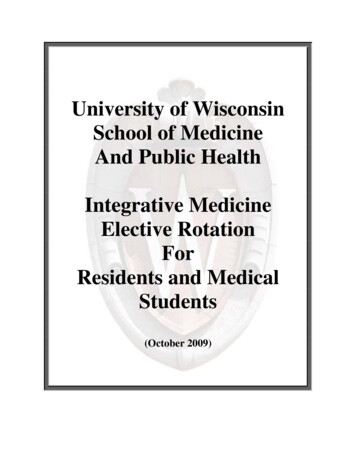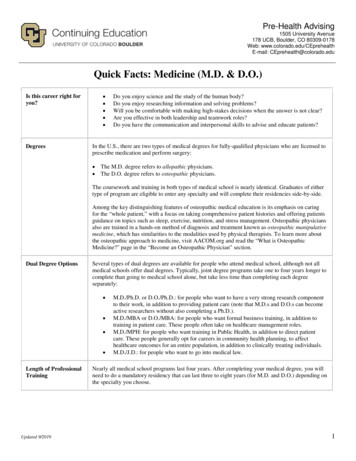
Transcription
Pre-Health Advising1505 University Avenue178 UCB, Boulder, CO 80309-0178Web: www.colorado.edu/CEprehealthE-mail: CEprehealth@colorado.eduQuick Facts: Medicine (M.D. & D.O.)Is this career right foryou?Degrees Do you enjoy science and the study of the human body?Do you enjoy researching information and solving problems?Will you be comfortable with making high-stakes decisions when the answer is not clear?Are you effective in both leadership and teamwork roles?Do you have the communication and interpersonal skills to advise and educate patients?In the U.S., there are two types of medical degrees for fully-qualified physicians who are licensed toprescribe medication and perform surgery: The M.D. degree refers to allopathic physicians. The D.O. degree refers to osteopathic physicians.The coursework and training in both types of medical school is nearly identical. Graduates of eithertype of program are eligible to enter any specialty and will complete their residencies side-by-side.Among the key distinguishing features of osteopathic medical education is its emphasis on caringfor the “whole patient,” with a focus on taking comprehensive patient histories and offering patientsguidance on topics such as sleep, exercise, nutrition, and stress management. Osteopathic physiciansalso are trained in a hands-on method of diagnosis and treatment known as osteopathic manipulativemedicine, which has similarities to the modalities used by physical therapists. To learn more aboutthe osteopathic approach to medicine, visit AACOM.org and read the “What is OsteopathicMedicine?” page in the “Become an Osteopathic Physician” section.Dual Degree OptionsSeveral types of dual degrees are available for people who attend medical school, although not allmedical schools offer dual degrees. Typically, joint degree programs take one to four years longer tocomplete than going to medical school alone, but take less time than completing each degreeseparately: Length of ProfessionalTrainingUpdated 9/2019M.D./Ph.D. or D.O./Ph.D.: for people who want to have a very strong research componentto their work, in addition to providing patient care (note that M.D.s and D.O.s can becomeactive researchers without also completing a Ph.D.).M.D./MBA or D.O./MBA: for people who want formal business training, in addition totraining in patient care. These people often take on healthcare management roles.M.D./MPH: for people who want training in Public Health, in addition to direct patientcare. These people generally opt for careers in community health planning, to affecthealthcare outcomes for an entire population, in addition to clinically treating individuals.M.D./J.D.: for people who want to go into medical law.Nearly all medical school programs last four years. After completing your medical degree, you willneed to do a mandatory residency that can last three to eight years (for M.D. and D.O.) depending onthe specialty you choose.1
Pre-MedClinical ExperienceOther Desired Traitsand Experiences Shadowing is defined as the observation of a health care provider while that person cares forpatients. We recommend spending ½ to 1 day each with the following types of clinicians:o A primary care physiciano A physician in a medical specialtyo A physician in a surgical specialtyo A physician assistanto One other clinician in a related field (such as optometry, dentistry, nursing, etc.) Direct patient interaction is defined as being in a position to offer comfort and moral supportto conscious patients in a health care environment. Most successful applicants have spent atleast one year volunteering for 4 hours/week (often more) in a direct patient interaction role.Your objectives are to become comfortable around sick and injured patients, to gain greaterunderstanding of the health care system, and to develop your communication skills in a clinicalsetting. Although most pre-medical students gain their direct patient interaction experience byvolunteering in a hospital or other clinical setting, you can also find paid work as a medicalassistant, CNA, EMT, or phlebotomist. Most such positions require training in advance; yourpre-health advisor can refer you to reputable training programs.Refer to the List of Core Competencies for Pre-Health Students, taking note that medical schoolsespecially emphasize the following: Updated 9/2019Scientific Inquiry: Your future work as a physician will require you to use strong criticalthinking skills on the job and to remain committed to lifelong learning. Getting involved in anindependent study project or another form of research is a great way to demonstrate that youenjoy asking new questions and to gain formal practice in critically analyzing your results andpresenting your findings. Research is defined as involvement in a scholarly or scientifichypothesis investigation that is supervised by an individual with verifiable research credentials.o M.D. schools: Although involvement in research is not an absolute requirement, mostsuccessful applicants have spent at least one year working/volunteering as a researchassistant, in a role that offers true intellectual engagement (i.e., attendance at labmeetings/journal club meetings, completion of a literature review, etc.).o D.O. schools: Research experience is not expected, but it is valued.Service Orientation: Physicians typically have strong altruistic motivations. Most successfulapplicants have consistently engaged in paid and volunteer positions involving non-clinicalservice to others since high school. Examples include retail/restaurant jobs, working as a tutor,and volunteering in roles that allows you to directly help others who are in need. Greaterconsideration is given to long-term efforts that exemplify the applicant’s dedication and depth ofcommitment to the service chosen.Cultural Sensitivity: Every physician cares for patients from a wide variety of racial, ethnic,cultural, and socioeconomic backgrounds. Thus, a history of experiences with people of diversebackgrounds is valued. Such experiences may include living abroad for a period of time,involvement with multicultural organizations, or other volunteer or paid positions that haveallowed you to understand and appreciate people whose backgrounds and belief systems arequite different from your own.Effective Teamwork and Leadership: Physicians must serve as both leaders and collaborators,so medical schools seek candidates who work well with others as a team of equals but alsoassume leadership roles as needed. Thus, a past history of collaborating successfully with otherson a team in a professional setting (such as in research, business, etc.) is valued, as is formalleadership training and experience. Examples of formal leadership roles include serving as ateaching assistant, a resident assistant in a dormitory, a wilderness guide, a manager at work, thecaptain of an athletic team, or an officer in the military.2
GPAMean GPAs for accepted medical school applicants, 7Although it is ideal to apply with mean cumulative and science GPAs at or above the nationwidemeans for accepted students, you can become a strong candidate with lower GPAs if your recentacademic history demonstrates a long-term trend of academic success.If your cumulative and/or science GPAs are currently below the means for accepted students at yourschools of interest, you can still become a competitive applicant if each of your term GPAs for thefour consecutive terms leading up to the time of application are at or above the values listed above. Ifyou have already completed the prerequisites, consider taking completing additional semesters withupper-division science elective courses. Another option is to complete a one-year pre-health master'sprogram (an “academic enhancement post-baccalaureate program”) before applying to medicalschool. The AAMC maintains a search engine of post-baccalaureate programs of this type.*Science GPA is defined as your average GPA in all biology, chemistry, physics and math courses.(CU Boulder prefixes of EBIO, IPHY, MCDB, NRSC, CHEM, PHYS, MATH.) Writing courses takenin these departments do not count toward your science GPA.Admissions TestMCAT: Medical College Admissions Test (scores typically “expire” after 2-3 years)Topics covered: Reading comprehension: the ability to read dense material quickly, for detail General Chemistry 1 and 2 Organic Chemistry 1 and 2 Biochemistry (CHEM 4611 or CHEM 4700) Intro to Molecular and Cellular Biology (MCDB 1150 or EBIO 1210) Human Physiology (covered in courses such as EBIO 1220, IPHY 3430, and IPHY 3470 &3480, but note that the IPHY options will require Anatomy as a prerequisite as of Fall 2018) Physics 1 and 2 Statistics General Psychology (use the AAMC’s Khan Academy materials to learn this subject) Introduction to Sociology (use the AAMC’s Khan Academy materials to learn this subject)Mean MCAT scores for accepted medical school applicants, nationwide:Updated 9/2019Mean score on eachof the four sectionsMean total scoreDO126504MD127-1285113
Reference Guides forSchool Selection M.D. schools: Medical School Admissions Requirements, available online and in book format (thetwo formats complement each other; they do not duplicate information) from the AAMC website. D.O. schools: Osteopathic Medical College Information Book, available as a free download or inbook format from the AACOM website.Names of CommonApplication Services M.D. schools: AMCAS (American Medical College Application Service). Opens in early Mayeach year (for the following year’s entering class). You can start filling it out in May but cannotsubmit it until June. D.O. schools: AACOMAS (American Association of Colleges of Osteopathic MedicineApplication Service). Opens in early May each year (for the following year’s entering class) andcan be submitted immediately. M.D. and D.O. schools in Texas: TMDSAS (Texas Medical & Dental Schools ApplicationService). Opens in early May each year (for the following year’s entering class) and can besubmitted immediately.RecommendedApplication TimingMedical schools conduct their admissions processes on a rolling basis, which means that earlyapplicants have a substantially greater chance of acceptance than those who apply even one monthlater in the application season. You will be considered an early applicant if you submit your commonapplication in the first month of the application season and follow the timeline below.Strongly recommended medical school application timeline:Number of Schools toWhich to ApplyTake MCATMay be taken after submitting common application, if necessary TMDSAS: By mid-June of application year AMCAS and AACOMAS: By mid-July of application yearStart Common App,Submit Transcripts All application services: First week of MaySubmit CommonApplication TMDSAS: By end of MayAMCAS and AACOMAS: By mid-June*Submit SupplementalApplicationsWithin two weeks of being prompted to complete each one. TMDSAS: Most will arrive in June AMCAS and AACOMAS: Most will arrive in JulyLetters ofRecommendationsubmitted TMDSAS: All submitted on your behalf by mid-JulyAMCAS and AACOMAS: All submitted on your behalf by mid-AugustWe recommend applying to a total of 10 to 15 schools. Even if you are applying to both M.D. andD.O. schools (which is true for most of our advisees), we strongly recommend that you cap your totalnumber of schools at 15. You simply won’t have enough time in the summer to complete theadditional essays in your supplementary applications in a careful, thoughtful, and timely manner ifyou try to apply to more than 15 schools.A note about public vs. private medical schools: You will have your best chance of admission at the public medical school(s) in your state ofresidency and at private medical schools. At private schools, all applicants are in the same evaluation pool. In contrast, most public medicalschools give strong preference to applicants who are residents of their state. This preferenceworks in your favor at your in-state school(s) but against you at all other public schools, where allout-of-state applicants compete for the small number of seats allocated for out-of-staters. If you a resident of Alaska, Idaho, Montana, or Wyoming (states that have no medical school oftheir own), you can participate in the WWAMI Medical Education Program. If you are a resident of Delaware (which also has no medical school of its own), you mayparticipate in the DIMER (Delaware Institute of Medical Education and Research) program.Updated 9/20194
Application FeeAssistanceThe AAMC offers a Fee Assistance Program that opens in mid-January each year. To be eligible, youand your immediate family members (including your parents) must collectively earn less than threetimes the poverty level for your family size. Dependent status doesn’t matter. Awards are limited, sowe recommend applying early if you think you may qualify. (Also, do not pay any of the fees listedbelow while you are awaiting your fee assistance decision, as the AAMC will not issue refunds.)Fee assistance includes: Reduced MCAT registration fee Complimentary set of MCAT preparation books and practice exams Complimentary access to the Medical School Admission Requirements website Waiver of the AMCAS application fee, with up to 16 medical school designations Up to 800 toward an updated psycho-educational or medical evaluation if you are applying forMCAT accommodations and an updated evaluation is required. If you qualify for the AAMC’s Fee Assistance Program, some medical schools will waive theirsecondary application fee.Letters ofRecommendationMedical schools typically request a total of 3 to 5 letters of recommendation. Check each school’swebsite to determine their specific LOR assortment requirement. Please provide each of yourevaluators with a copy of our Pre-Health Guidelines to Recommenders form.We recommend the following assortment of letters:1. Letter from a CU Boulder science* faculty member, ideally one who has taught you in a lectureor seminar course and thus can comment upon your intellectual engagement as a student.2. Letter from another faculty member. This person can be from CU Boulder or another school youhave attended, and can be from any department. Again, it’s ideal if this person has taught you in alecture or seminar course and can therefore attest to your intellectual engagement as a student.3. Letter from a supervisor from a work or volunteer experience who can attest to your intrapersonaland interpersonal skills. If you have been strongly involved in research but did not take a coursefrom your research P.I., we recommend asking your P.I. to write this letter.4. [Optional] One more letter from a writer from any of the above categories.If you are applying to D.O. schools, you will need a letter written by a D.O. whom you’veshadowed who can attest to your understanding of and interest in osteopathic medicine.*“Science,” for the purpose of applying to medical school, is defined as Biology, Chemistry,Physics, and Math (CU Boulder prefixes: MCDB, EBIO, IPHY, NRSC, CHEM, PHYS, MATH)A note about Pre-Health Committee Letters of Evaluation:CU Boulder does not offer Committee Letters, except to students who complete our PostBaccalaureate Health Professions program and complete all of the steps (and meet alldeadlines) in our Committee Letter Process. Plan ahead: This process begins in the fallsemester of the academic year before your application cycle and takes 8 months tocomplete. Please visit www.colorado.edu/ceprehealth Letters of Recommendation fordetails.Updated 9/20195
1505 University Avenue 178 UCB, Boulder, CO 80309-0178 . Quick Facts: Medicine (M.D. & D.O.) Is this career right for you? Do you enjoy science and the study of the human body? Do you enjoy researching information and solving problems? . The coursework and training in both types of medical school is nearly identical. Graduates of either
